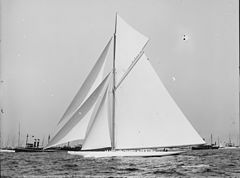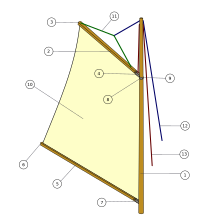Gaff rig



Gaff rig[1]is asailingrig (configuration of sails, mast and stays) in which thesailis four-cornered,fore-and-aft rigged,controlled at itspeakand, usually, its entireheadby aspar(pole) called thegaff.Because of the size and shape of the sail, a gaff rig will have runningbackstaysrather than permanent backstays.
The gaff enables a fore-and-aft sail to be four sided, rather than triangular. A gaff rig typically carries 25 percent more sail than an equivalentBermuda rigfor a given hull design.[2]
A sail hoisted from a gaff is called agaff-rigged(or, less commonly,gaff riggedorgaffrigged)sail.[3]
Description
[edit]Gaff rig remains the most popularfore-aft rigforschoonerandbarquentinemainsails[citation needed]and othercourse sails,andspankersails on asquare riggedvessel are always gaff rigged. On other rigs, particularly thesloop,ketchandyawl,gaff rigged sails were once common but have now been largely replaced by theBermuda rigsail,[4]which, in addition to being simpler than the gaff rig, usually allows vessels to sail closer to the direction from which the wind is blowing (i.e. "closer to the wind" ).[citation needed]
The gaff is hoisted by twohalyards:

- Thethroat halyardhoists the throat of the sail (the end closer to the mast) at the forward end of the gaff and bears the main weight of the sail and the tension of theluff.[5]
- Thepeak halyardlifts the aft end of the gaff and bears theleechtension. Small craft attach the peak halyard to the gaff with a wire span with eyes at both ends looped around the gaff and held in place with small wooden chocks, larger craft have more than one span. Peak halyards pull upwards, approaching the gaff at right angles.[6]

Additionally, agaff vangmay be fitted. It is a line attached to the end of the gaff which prevents the gaff from sagging downwind. Gaff vangs are difficult to rig on theaft-most sail, so are typically only found on schooners or ketches, and then only on the foresail or mainsail.[citation needed]
A triangular fore-and-aft sail called a jib-headedtopsailmay be carried between the gaff and themast.[7]
Gunter-riggedboats are similar, smaller vessels on which a spar (commonly, but incorrectly called the gaff) is raised until it is nearly vertical, parallel to the mast and close adjacent to it. Topsails are never carried on gunter rigs.
Thespritsailis another rig with a four-sidedfore-aft sail.Unlike the gaff rig where theheadhangs from a spar along its edge, this rig supports theleechof the sail by means of a spar named asprit.The forward end of the sprit is attached to themastbut bisects the face of the sail, with the after end of the sprit attaching to thepeakand/or theclewof the sail.
Sailing characteristics (small craft)
[edit]For a given sail area a gaff rig has a shorter mast than aBermudan rig.In short-ended craft with full body, heavy displacement and moderateballastratio, it is difficult to set enough sail area in the Bermudan rig without a mast of excessive height and acentre of effort (CE)too high for the limitedstabilityof thehull.[8]Because of its lowaspect ratio,the gaff rig is less prone tostallingif oversheeted than something taller and narrower.[9]
Reaching with gaff sails
[edit]Whilstreaching,the CE being set further back, will encourage a small craft to bear up into the wind, i.e. strongweather helm.The boat builder can compensate for this at design stage, e.g. by shifting the keel slightly aft, or having two jibs to counter the effect. The gaff-cutter is in fact a very popularsailplanfor small craft.[citation needed]The helmsman can reduce weather helm significantly, simply by sheeting out the mainsail. Sheeting out may appear to create an inefficient belly in the sail, but it is often a pragmatic alternative to having a heavy helm. A swing keel lifted halfway is the perfect treatment for weather helm on a gaffer.[citation needed]The usual adjustments to mast rake, or even bowsprit length may be made to a gaffer with persistent heavy weather (or lee) helm.
Running with gaff sails
[edit]On a gaff-rigged vessel, any heading where the wind is within 20 degrees of dead aft is considered arun.[10]Whenrunningwith a gaff rig, the CE of the mainsail may actually be overboard of the hull, in a stiff wind the craft may want tobroach.Running goose winged with a balloon staysail poled out to windward will balance the CE; Nick Skeates circumnavigatedWylo IIwith this configuration.[11] In light winds, or when racing, awatersailmay also be set.
Gaffers Day
[edit]Since 1972, theSydney Amateur Sailing Clubhas regularly hosted a Gaffers Day for any classic sailing boat that can "hoist a spar". Up to 90 vessels from around Australia take part in sailing on Sydney Harbour in a practical demonstration of the skills and technology used in the nautical past.[12]
Gallery
[edit]-
Gaff rigged schoonerJ. & E. Riggin.Her sails, from left to right, are:jib,staysail,gaff foresail, gaff mainsail, and, above that, a maingaff topsail
-
Gaff rigged CutterPartridge 1885.
-
A near-vertical gaff allows thisGunter-rigged boat to carry a triangular sail that is similar to theBermuda rig
-
Gaffelaar,byJohannes Christiaan Schotel,depicting both gaff and square-rigged boats
-
Gaff rigged yachts race onSydney Harbour,c. 1900
-
Carmita,racingcutter
-
Governor Ames,five-mastedschooner
-
Victory Chimes,National Historic Landmark
-
Zaca,owned byErrol Flynn
-
Traditional Dutch sailing barge
-
The yacht of theVOC-Chamber of Rotterdam,by Jacob van Strij
-
The schoonerRose Dorotheain 1907
-
Traditional Galway hooker, Ireland, June 2010
-
Original iconic Canadian schooner Bluenose
See also
[edit]References
[edit]- ^"The Gaff Rig Page".Archived fromthe originalon December 3, 2008.Retrieved2008-10-05.
- ^Philips-Birt, Douglas (1954).Rigs and Rigging of Yachts.W&J Mackay & Co. Ltd. p. 176.
- ^"N-gram comparison of 'gaff-rigged', 'gaff rigged', 'gaffrigged', 1900–2008".Google books Ngram Viewer.Google Inc.Retrieved17 February2013.
- ^Cunliffe, Tom (1992).Hand, Reef and Steer.London: Adlard Coles Nautical. p. 12.
- ^Leather, John (2001).The Gaff Rig Handbook: History, Design, Techniques, Developments(2nd ed.). WoodenBoat Books. p. 32.ISBN978-0-937822-67-8.
- ^Leather (2001),p. 33.
- ^Leather (2001),p. 54.
- ^Philips-Birt (1954),pp. 47–48.
- ^Cunliffe (1992),p. 15.
- ^Cunliffe (1992),p. 118.
- ^Cunliffe (1992),p. 120.
- ^"Gaffers Day".
Further reading
[edit]- Rousmaniere, John (1998).The Illustrated Dictionary of Boating Terms: 2,000 Essential Terms for Sailors & Powerboaters.W.W. Norton.ISBN978-0-393-04649-6.














